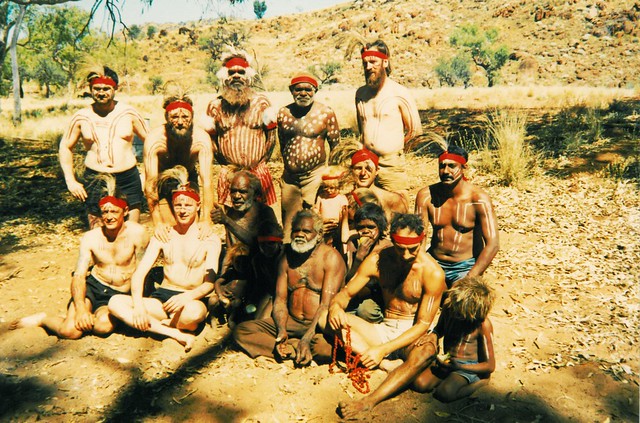The Tjukurrpa story of the Ngintaka Man is the most important one for the Anangu. Every evening the song in many verses was sung at the campfire, each verse had its own dance connected with it.
The Ngintaka Man was a horrible creature. He had stolen the Anangu’s grinding stone (djiba). With this tool he travelled through the country followed by the Anangu who tried to get the stone back. It was during this trip that the land of the Anangu was created, way back in the Tjukurrpa. The several spots he visited are still very much recognisable and are still holding Ngintaka Man’s spirit. Some are bad places, some are good, some are sacred for men and some for women.
On one of these spots the Ngintaka Man had stopped and started digging for tjanmatja’s {bush onions}. This whole area is still scattered with bush onions in the form of big round rocks some up to 3 metres high.

In a nearby rock shelter we saw the Ngintaka Man petrified in a huge square rock in the middle of the cave. On the walls were rock paintings. We could enter the cave and were stimulated to rub Ngintaka Man as this was a place of good spirits.
As the small group of four black and six white men had become very familiar with each other by now, it was natural that we all joined in to perform the Ngintaka Man Dreaming in this cave, around the (petrified) Ngintaka Man.

At another occasion, there where the Ngintaka Man had taken a rest, a rock showed Ngintaka in a resting position. Before we could reach the spot, Sammy rushed in front of us and shouted: “Do not come nearer and do not touch because this place is bad.”. To enforce this, he shouted: “and this is true!” although the expression in his eyes alone would have been enough to stop us coming closer.
At another place, we were told that the Ngintaka Man had vomited. That was the reason of all the good bush food around Angatja.
The Dreaming Story ends with the Anangu catching and killing the Ngintaka Man and so they got their djiba back. Also, this spot can be seen but it is outside Angatja’s land somewhere in what is now Western Australia. A cylindrical rock in that area is the dead Ngintaka Man – “and this is true!”.
Close to the end of our stay in Angatja after all these “lessons” we were “initiated”. Of course, not in the traditional way, but we all received the “pulturo”, the red headband that boys receive after the initiation. Later, also the white women received the “pulturo” because they went through a similar process.
There was a lot of laughter and noise when we received the pulturo because if we would now show up in Amata with the pulturo the konga would all fall for us! Further details about the other information we received regarding this subject can be easily guessed.

